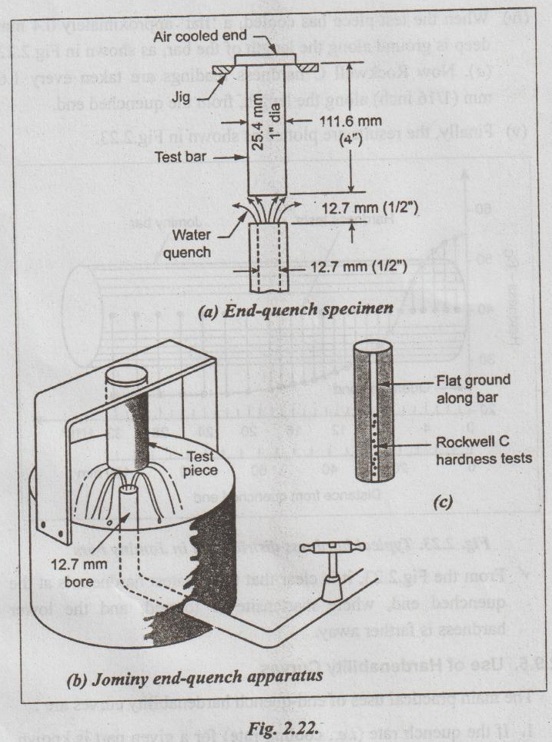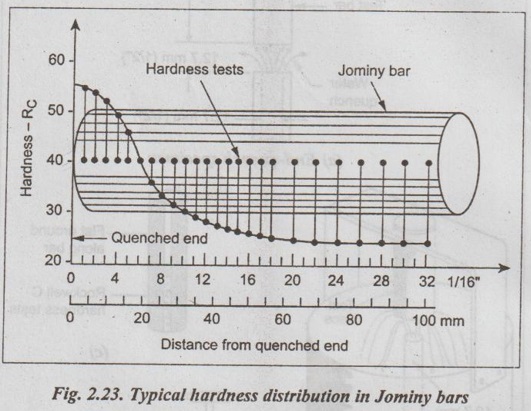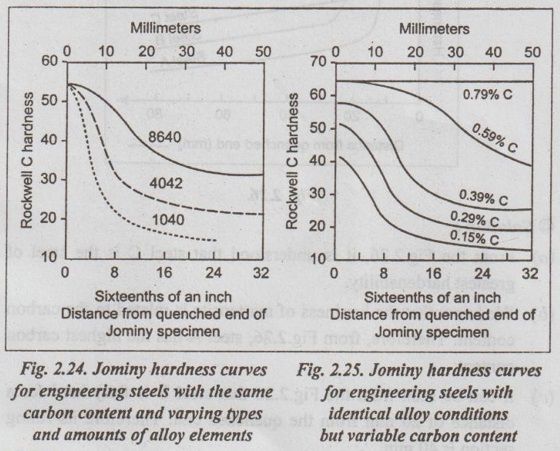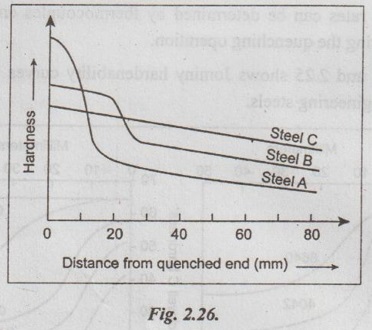The term hardenability refers to the ease with which hardness may be attained.
HARDENABILITY
1. What is meant by Hardenability?
✓ The term hardenability refers to the ease with which hardness may be attained. That is, the ease with which a steel will transform to hardened structure on quenching is called hardenability.
✓ The hardenability of a steel is defined as that property which determines the depth and distribution of hardness induced by quenching from the austenitic condition.
✓ In other words, hardenability is a measure of ease of forming martensite.
✓ For instance, one can say that alloy steels are more hardenable than plain carbon steels because they form martensite more easily.
✓ Thus the hardenability is a measure of the depth to which full hardness can be attained.
2. Hardness Vs Hardenability
✓ The term 'hardness' should not be confused with the term 'hardenability'.
✓ The term hardness is the property of a material by virtue of which it is able to resist abrasion, indentation and scratching. It is a mechanical property related to strength and is a strong function of the carbon content of a metal. The hardness can be measured by the methods like Brinell, Rockwell and Vickers↑.
✓ On the other hand, hardenability is the susceptibility of a material to get hardened. It is affected by the alloying elements in the material and grain size. The hardenability can be measured by the Jominy end-quench test method.
† For more details on hardness and its testing methods, refer Unit 5, Section 5.13.
3. Factors Affecting Hardenability
The hardenability of a steel depends on the following factors:
1. The composition of the steel.
2. The austenitic grain size.
3. The structure of the steel before quenching.
4. The quenching medium and the method of quenching.
4. Determining Hardenability (Jominy End-Quench Test)
✓ The most widely adopted method of determining hardenability is the Jominy end-quench test method.
✓ The Jominy end-quench test method is universally adopted, because:
(i) It is relatively easy to perform.
(ii) It has excellent reproducibility.
(iii) It gives information useful to a designer as well as manufacturer.
1. End-Quench Specimen
A bar of the steel to be tested is machined to give a cylinder 111.6 mm (4 inch) long and 25.4 mm (1 inch) in diameter with an upper lip. The end-quench specimen and testing arrangement are shown in Fig.2.22 (a) and (b) respectively.
2. Testing Procedure
(i) The standard test-piece (Fig.2.22 (a)) is heated to above the upper critical temperature of the steel i.e., until it becomes completely austenitic.
(ii) It is then very quickly transferred from the furnace, and immediately dropped into position in the frame of the apparatus shown in Fig.2.22 (b).

(iii) Here it is quenched at one end only, by a standard jet of water at 25°C. Thus, different rates of cooling are obtained along the length of the test-piece.
(iv) When the test-piece has cooled, a 'flat' approximately 0.4 mm deep is ground along the length of the bar, as shown in Fig.2.22 (c). Now Rockwell C hardness readings are taken every 1.6 mm (1/16 inch) along the length, from the quenched end.
(v) Finally, the results are plotted as shown in Fig.2.23.

✓ From the Fig.2.23, it is clear that the greatest hardness is at the quenched end, where martensite is formed; and the lower hardness is farther away.
5. Use of Hardenability Curves
The main practical uses of end-quench hardenability curves are:
1. If the quench rate (i.e., cooling rate) for a given part is known, the Jominy hardenability curves can predict the hardness of that part.
2. If the hardness at any point can be measured, the cooling rate at that point may be obtained from the hardenability curve for that material.
Cooling rates can be determined by thermocouples embedded in the bars during the quenching operation.
Fig.2.24 and 2.25 shows Jominy hardenability curves for various common engineering steels.

Note
A term connected with hardenability is ruling section. The ruling section of a steel is the maximum diameter of bar which can be hardened throughout by a quenching treatment.
Example 2.1
Jominy hardenability curves for three different steels are shown in Fig.2.26.
(a) Which curve relates to the steel of greatest hardenability?
(b) Which curve relates to the steel of highest carbon content?
(c) Estimate the ruling section of steel B.

● Solution:
(a) From the Fig.2.26, it is understood that steel C is the steel of greatest hardenability.
(b) We know that the hardness of martensite is related to the carbon content. Therefore, from Fig.2.26, steel A has the highest carbon content.
(c) It can be seen from the Fig.2.26 that steel B is fully hard for a distance of 20 mm from the quenched end. Therefore its ruling section is 40 mm.
No comments:
Post a Comment